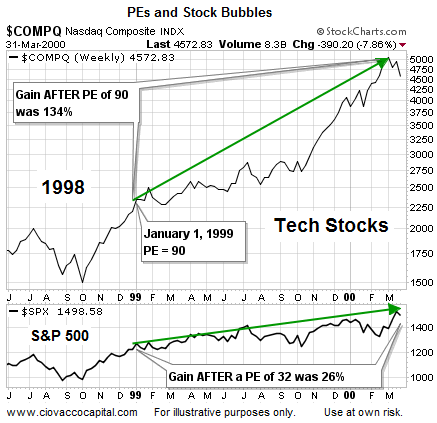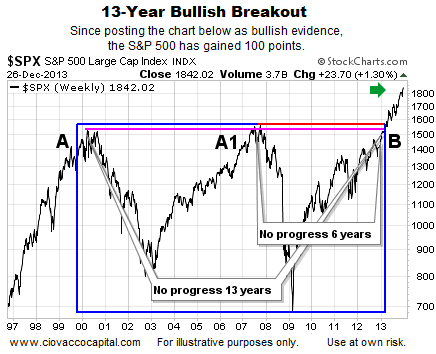Investors Need Plans For Extreme Outcomes
In calculus, the concept of “limits approaching infinity” speaks to extreme outcomes. Like a mathematician, investors can look for holes in their investment approach by contemplating extreme economic and market outcomes. For example, we should be able to respond to the questions below with little or no hesitation:
- How would I handle scenario A where the S&P 500 rises sharply for three more years?
- How would I handle scenario B where the S&P 500 drops 50% in the next two years?
If we have plans in place for extreme outcomes, we can probably handle most scenarios, including those that fall in between scenarios A and B. We can’t predict the future, but we know bull markets/bubbles can last a lot longer than rational people believe, and it is not a question of if another 30-50% bear market is coming, but when.
Therefore, it is prudent to have contingency plans in place for both ends of the risk-reward spectrum. We will also touch on reasons to keep an open mind about another bullish year in 2014.
A Very Common Investment Stance – Too Much Cash
After countless conversations with investors over the last twenty years, I can confidently state that a common issue is having too much cash on the sidelines during bull markets. We are in a bull market now, and will remain in a bull market until the evidence shifts. How long will the bull last? No one knows, but another three years is one very real possibility. Fear of “bad things happening” is what understandably keeps vast quantities of investable assets parked under mattresses, in money market funds, and gathering dust in checking accounts. One way to combat that fear, while managing downside risk, is to “stay in the now” and adjust as the evidence changes.
Scenario A: Stocks Rise For Three More Years
In this article, we focus on scenario A, or stocks rising for three more years. Our purpose is not to forecast where stocks will be in three years, but rather to emphasize the importance of having plans in place in the event stocks surprise on the upside as they did between 1997 and 2000.
Chronic Underinvested Syndrome Can Kill You
We all know being underinvested speaks to opportunity costs, but just how much harm can it do to your family and net worth? Let’s assume we have three hard working people that had managed to build a $1,000,000 nest egg as of December 31, 1996. We will call them 100% Bob, 50% Sally, and 15% Dave. Our first contestant, 100% Bob, decided “we are in a bull market and I want to be in stocks”; he invests 100% of his $1,000,000 nest egg in the S&P 500 ETF (SPY). Contestant two, 50% Sally, has been so busy with her career and family that she could never find the time to do something with “all that cash”. Sally enters 1997 with 50% in cash and 50% in stocks. Contestant three, 15% Dave, is a common character in the hit Broadway production “Stocks Can’t Keep Going Up”. Dave enters 1997 with 15% of his $1,000,000 in stocks and 85% of it parked in cash. Since cash is earning next-to-nothing in 2014, for illustrative purposes, cash earns nothing in the hypothetical example below. The chart below shows the growth of $1,000,000 based on the S&P 500’s return (SPY) and the three different allocations – 100% Bob, 50% Sally, and 15% Dave.

How much did Chronic Underinvested Syndrome cost 50% Sally? In March 2000, 50% Sally’s portfolio was worth $583,409 less than 100% Bob’s. How about 15% Dave? His underinvested portfolio was worth $991,795 less than 100% Bob’s.
2014-2016 Rise Is Not As Farfetched As You Might Think
Before you dismiss bullish scenario A, keep in mind, stock valuations were already stretched in the 1990s and talk of bubbles was common (sound familiar?). As shown in the chart below, with a PE of 90, the NASDAQ gained an additional 134% from January 1, 1999 to the euphoric peak in March 2000. With a stretched PE of 32, the S&P 500 gained an additional 26%.

13-Year Breakout Favors Bulls in 2014
In terms of the current outlook for stocks, the chart below, from The Most Underappreciated Bullish Evidence, also tells us a 1997-2000-like move may not be as farfetched as you think.

From an economic perspective, we understand 2014 is quite different from the late 1990s; we also acknowledge that scenario B (a horrible bear market) is well within probabilistic reason.
Economic Confidence Should Assist Stocks
Investors flock to stocks when they are confident. Conversely, when they are concerned about the economy and earnings, they gravitate toward more defensive-oriented bonds. Thursday, traders were greeted with news supporting the “we are confident case”.
Americans in January became the least pessimistic about the economic outlook in five months amid signs the expansion was gaining momentum heading in 2014. The gap between positive and negative expectations for the economy shrank to minus 5 this month, its best reading since August, from minus 11 in December, according to data from the Bloomberg Consumer Comfort Index released today.
Investment Implications: Preparing For Scenarios A & B
Are we talking about making a blind shift to a 100% stock portfolio? Absolutely not; the objective of the article is to highlight (a) the importance of having a game plan for both bull and bear markets, and (b) the possible impact of being underinvested if stocks rise longer than you anticipate. There are many prudent ways to prepare for scenario A and scenario B. Regardless of the approach, they all involve studying markets, building a risk-management system, backtesting the system, developing rules, and following the rules 100% of the time. If you are new to these concepts, the articles below provide simple examples of systems and risk-management strategies:
- You Need A Plan For Next Inevitable Bear Market
- Stock Bubbles: Can Investors Profit While Monitoring Risk?
- 2007/2013: You Will Never Look At The Markets The Same Way Again
- Tired Of Missing Rallies? 4 Ways To Improve Your Game
